Nof S.Y. Springer Handbook of Automation
Подождите немного. Документ загружается.


Digital Manufacturing and RFID-Based Automation 49.3 Digital Manufacturing by RFID-Based Automation 865
tions of RFID technology in manufacturing automation
economically feasible.
For manufacturers, it is becoming increasing im-
portant to design and integrate RFID information into
various enterprise application software packages and
to solve connectivity issues relating to plant floor
and warehousing. Real-time manufacturing process au-
tomation is dependent on the principle of closed-loop
automation that senses, decides, and responds from
automation toplant andenterprise operations;for exam-
ple, a pharmaceuticals manufacturer [49.23] makes use
of RFIDto trace the route or history taken by an individ-
ual product at multiple locations along the production
line. This allows the pharmaceuticals manufacturer eas-
ily to trace all final products that might have been
affected by any production miscarriage. An aerospace
company named Nordam Group uses RFID to track its
high-cost molds. Through the use of RFID tags, they
save the cost of real-time tool tracking. With growing
emphasis on real-time responsiveness, manufacturers
are seeking to control more effectively the production
processes in real time in order to eliminate waste and
boost throughput. The desire to extend supply-chain ex-
ecution dispatching within a plant makes closed-loop
automation an imperative. The inability to achieve true
closed-loop manufacturing process automation presents
one of the greatest barriers to successful real-time
operation strategies. Critical elements that support man-
ufacturing process automation include:
•
Dynamic information technology (IT) systems to
support high-mix, variable environments
•
Dynamic modeling, monitoring, and management
of manufacturing resources
•
Real-time synchronization between activities in the
offices, manufacturing plant, and supply chain
•
Visibility of the real-time status of production re-
sources
Although some previous studies [49.24–26]have
shownthat RFIDtechnology has thepotential to address
these problems and has great potential for supporting
manufacturing automation, critical deficiencies in the
current systems in keeping track of processes under
changing conditions include:
•
Lack of integration of manufacturing with the sup-
ply chain
•
Lack of real-time shop-floor data for predictive
analysis and for decision support
•
Lack of a common data model for all operational
applications
•
Inability to sense and analyze inputs ranging from
the factory floor to the supply chain
•
Ineffective integration links between manufacturing
process automation and enterprise IT applications
•
Inability to provide intelligent recommendations
and directives to targeted decision points for quick
action.
In light of these, this chapter presents a review
of the RFID-based manufacturing process automation
system (MPAS), which embraces heterogeneous tech-
nologies that can be applied in the manufacturing
process environment with the objective of enhancing
digital manufacturing at the level of automation across
the enterprise and throughout the value chain. The pro-
posed RFID-based manufacturing process automation
system aims to address these deficiencies.
49.3.1 Key RFID Technologies
RFID is an advanced automatic identification technol-
ogy, which uses radiofrequency signals to capture data
remotely from tags within reading range [49.27, 28].
The basic principle of RFID, i. e., the reflection of
power as the method of communication, was first de-
scribed in 1948. One of the first applications of RFID
technology was identify friend or foe (IFF) detection
deployed by the British Royal Air Force during World
War II. The IFF system allowed radar operators and pi-
lots to distinguish automatically between friendly and
enemy aircraft using radiofrequency (RF) signals. The
main objective was to prevent friendly fire andtoaid
the effective interception of enemy aircraft. The ra-
diofrequency used is the critical factor for the type of
application for whichan RFIDsystem isbest suited. Ba-
sically, the radiofrequencies can be classified as shown
in Table 49.1.
A typical RFID system contains several compo-
nents, including an RFID tag, which is the identification
device attached to the item to be tracked, and an RFID
reader and antenna, which are devices that can recog-
nize the presence of RFID tags and read the information
stored on them. After receiving the information, in or-
der to process the transmission of information between
the reader and other applications, RFID middleware
is needed, which is software that facilitates the com-
munication between the system and the RFID devices.
Figure 49.5 shows a typical RFID system to illustrate
how the pieces fit together.
As shown in Fig. 49.5, radio frequency (RF) tags are
devicesthat contain identificationand other information
Part F 49.3

866 Part F Industrial Automation
Table 49.1 Comparison of RFID frequency bands and their respective applications
Frequency Approximate Data speed Cost of tags Applications
read range
Low frequency (LF) < 5cm (passive) Low High Animal identification
(125kHz)
Access control
High frequency (HF) 10cm−1m (passive) Lowtomoderate Medium to low Smart cards
(13.56MHz)
Payment
Ultrahigh frequency (UHF) 3–7m (passive) Moderate to high Low Logistics and supply chain
(433, 868–928 MHz)
Pallet and case tracking
Baggage tracking
Microwave 10–15m (passive) High High Electronic toll collection (ETC)
(2.45 and 5.8GHz)
20–40m (active) Container tracking
Client computer RFID reader RFID antenna RFID tag
Enterprise application
and RFID middleware
Fig. 49.5 Infrastructure for an RFID system
that can be communicated to a reader from a distance.
The tag comprises a simple silicon microchip attached
to a small flat aerial which is mounted on a substrate.
RFID tags (Fig.49.6) can be divided into three main
types with respect to the source of energy used to power
them:
1. Active tags: use a battery to power the tag trans-
mitter and receiver to broadcast their own signals
to readers within the life of batteries. This al-
lows them to communicate over distances of several
meters.
123
5
6
78
4
1. Badge
2. Button
3. Cloth tag
4. Card
5. Glass bead
6. Key fob
7. Label
8. Wristband
Fig. 49.6 Samples of different types of tags
2. Semipassive tags: have built-in batteries to power
the chip’s circuitry, resist interference, and circum-
vent a lack of power from the reader signal due to
long distance. They are different from active tags in
that they only transmit data at the time a response is
received.
3. Passive tags: derive their power from the field
generated by the reader without having an active
transmitter to transfer the information stored.
The reader is called an interrogator, and it sends
and receives RF data to and from the tag via antennas.
Fig. 49.7 Example RFID reader
Part F 49.3
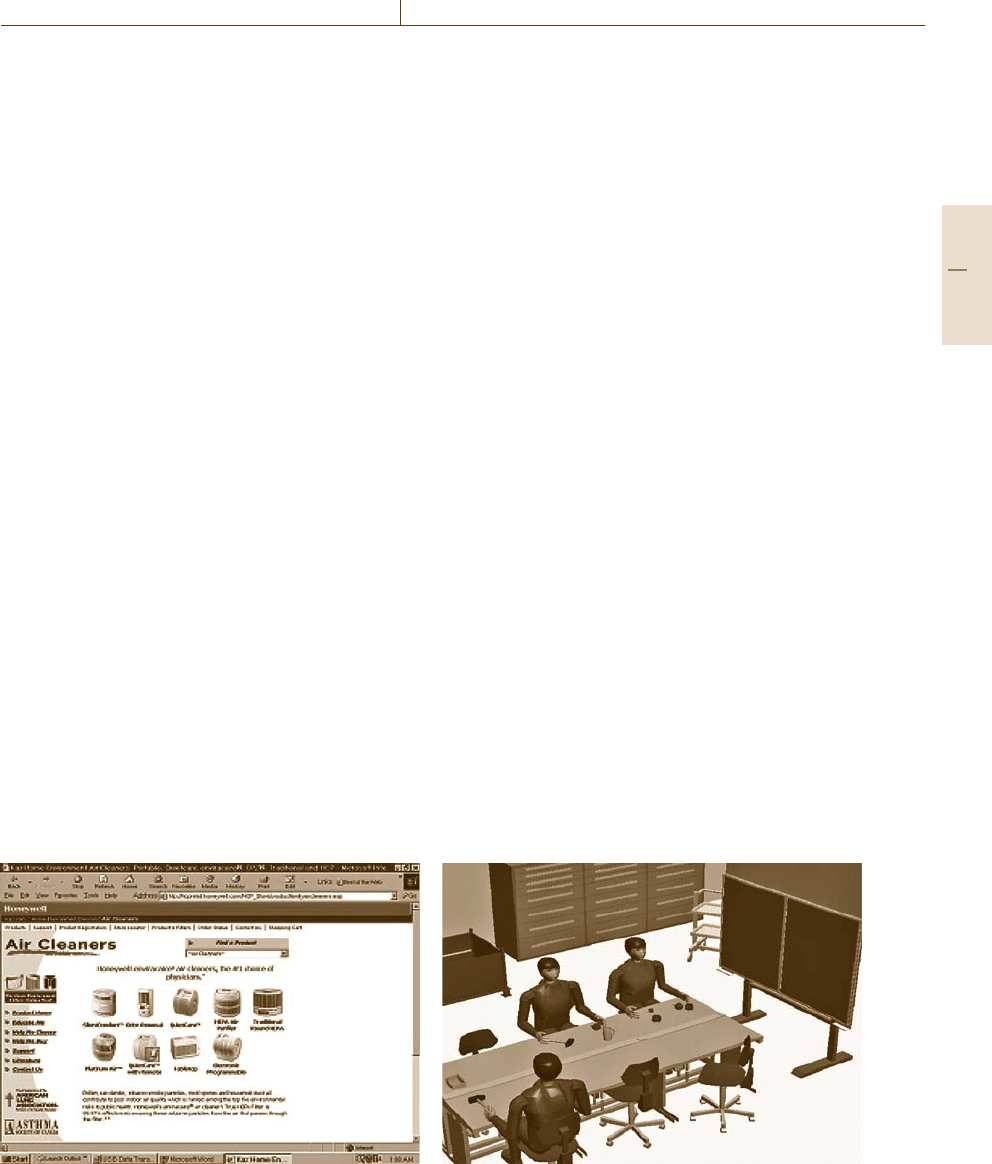
Digital Manufacturing and RFID-Based Automation 49.4 Case Studies of Digital Manufacturing and RFID-Based Automation 867
AsshowninFig.49.7, the reader contains a transmit-
ter, a receiver, and a microprocessor. The reader unit
also contains an antenna as part of the entire system.
The antennas broadcast the RF signals generated by the
reader and receive responses from tags within range.
The data acquired by the readers is then passed to a host
computer, which may run specialist RFID software or
middleware to filter the data and route the data to the
correct application to be processed into useful informa-
tion. Middleware refers to software that lies between
two interfaces; RFID middleware is software that lies
between the readers and the data collection systems. It
is used to collect and filter data from readers. It can
transfer those useful data, which are filtered, to the data
collection system.
49.3.2 Applications
of RFID-Based Automation
in Digital Manufacturing
Manufacturing process automation relies heavily on ef-
ficient and effective automatic tracking of assets during
manufacturing. The tracked assets include physical as-
sets such as equipment,raw materials, work-in-progress
(WIP), finished goods, etc. Efficient automatic tracking
of assets is beneficial for manufacturers. One of the ma-
jor challenges for manufacturers today is management
of their movable assets. Managing assets includes activ-
ities suchas locating assets, tracking status, and keeping
a history of flow information. If the location of an as-
set is not effectively located, workers are required to
spend much time searching for it, which results in in-
creased process costs. As a result, manufacturers are
turning to RFID to investigate whether they can use
it to bring the benefits of managing assets individu-
ally, real-time location tracking of assets, and better
information accuracy and automationinto theirbusiness
operations.
Examples can be found in the garment indus-
try [49.23]. The manufacturer ties the RFID tags to the
bundles and sends them to the sewing workstation. At
each process station, the data stored in the RFID tag is
captured. The real-time status of the WIP can be auto-
matically captured during the manufacturing process. It
is also interesting to note that Boeing and Airbus are
moving forward and have created an RFID strategy for
airplane manufacturing [49.20, 28], as a component to
meet USDepartment of Defense mandates. The RFID
tags are attached to removable parts of the airplane to
aid the control of maintenance programs. In the present
study, four major areas of RFID in manufacturing pro-
cess automation are introduced.
49.4 Case Studies of Digital Manufacturing and RFID-Based Automation
49.4.1 Design of Assembly Line
and Processes for Motor Assembly
Kaz (Far East) Limited, formerly Honeywell Consumer
Product (HK) Ltd., is a multinational manufacturing
Fig. 49.8 Home comfort products from Kaz
company with about 45 employees in Hong Kong and
around 2650 in China. Its corporate headquarters, de-
sign, sales offices, and production plants are widely
dispersed in Europe, North America, and Asia, as are
its key suppliers and customers. As shown in Fig. 49.8,
Fig. 49.9 Virtual assembly station for assembling a motor
Part F 49.4
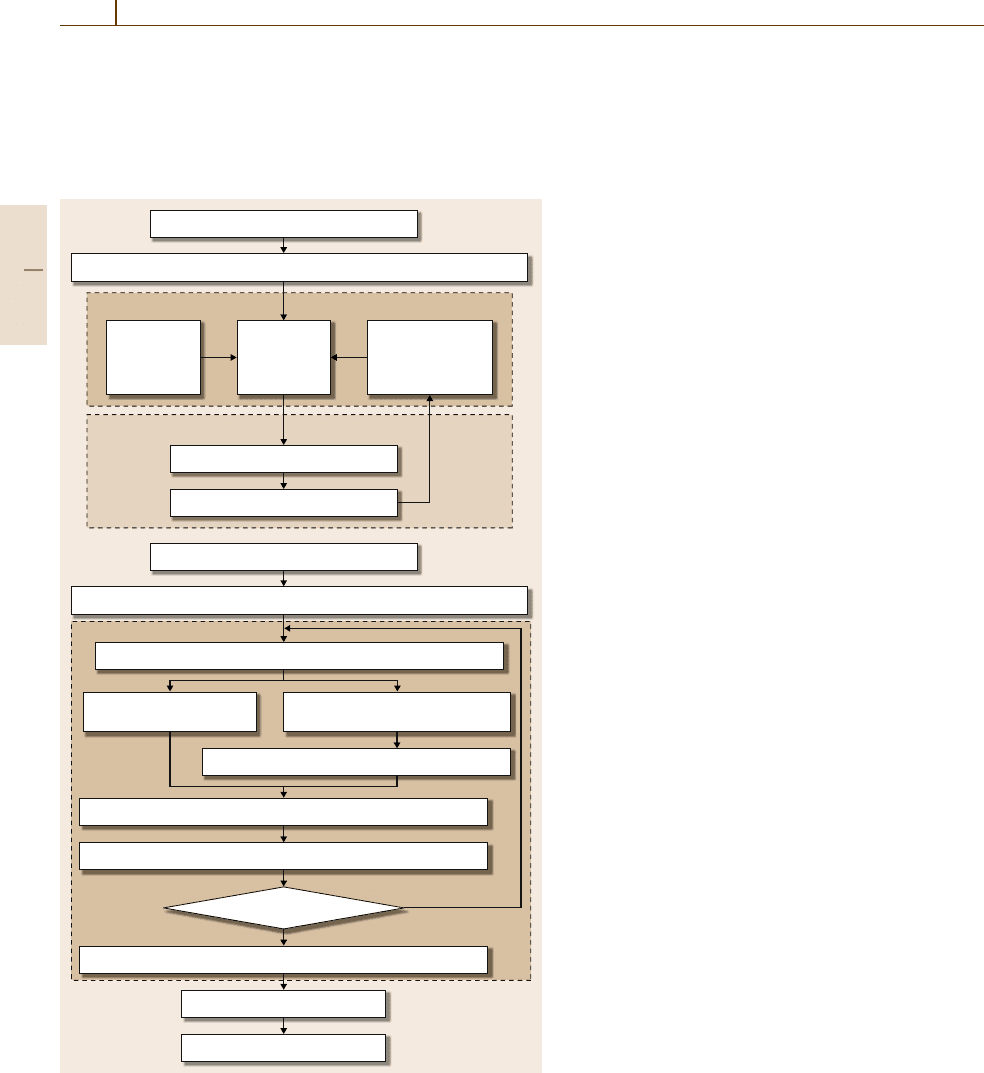
868 Part F Industrial Automation
the company has been involved in the seasonal products
business which includes home comfort products such
as portable air cleaners, humidifiers, heaters, fans, etc.
It delivers a portfolio of innovative products and trusted
brands to serve customers worldwide, though most of
VMISTraining
a)
b)
Performance
evaluation and
monitoring
Virtual world
Real world
Converting the product design specifications into engineering optics specifications
Converting the product design specifications into engineering optics specifications
Design the optical system using computer-aided optics design software
Trial run injection molding for the prototype lenses
Form and surface roughness measurement for the prototype lenses
Optical quality evaluation like MTF testing and focal length inspection
Output
Actual production
No
Yes
Final design, part programming and master scheduling for production
Pass the optical quality test ?
Machining prototype plastic
lenses for the lens system
Machining test mold inserts and test
mold bases for the lenses
Identification of product design specifications
Identification of product design specifications
Actual production
Output
Fig. 49.10a,b A comparison between (a) the conventional ap-
proach and
(b) the virtual manufacturing approach for the design
and manufacture of precision optics (MTF – modular transfer func-
tion)
their products are sold to customers in North America
and Europe.
The company possesses a number of assembly lines
and clusters for assembling the motors for the home
comfort products. For new assembly line planning,
there are many factors which affect the efficiency and
throughput rate. These include the design of the work-
place, the investigation of the assembly process, the
allocation of the resources (e.g., number of workers),
and the scheduling of the assembly lines. Convention-
ally, the production team was essentially empowered to
use their own judgment in deciding what, when, and
how to setup the assembly lines, based on their own ex-
perience. The optimal efficiency, throughput rate, and
quality for new assembly lines can only be obtained
through iterative trial operations and process refine-
ment. This is not only time consuming but also costly.
With the use of the VM approach, Kaz can investi-
gate the assembly processes and optimum utilization of
resources through modeling and simulation. The feasi-
bility of the assembly process plan (Fig. 49.9) can be
evaluated prior to the actual production. As a result, the
time and cost of setting up new assembly operations can
be significantly reduced.
49.4.2 A VM System for the Design
and the Manufacture
of Precision Optical Products
The conventional approach to the design and the man-
ufacture of precision optical products is based on
a trial-and-error method. As shown in Fig.49.10a, the
optical product is designed using computer-aided optics
design software (Fig.49.11b). Then a lens prototype is
made by either direct machining or injection-molding
from a test mold insert machined by ultraprecision
machining (Fig.49.12). Quality tests will then be
conducted on the prototype lenses or mold inserts
(Fig.49.13). It should be noted that the design, pro-
totyping, and evaluation processes are iterative until
a satisfactory mock-up is found. This is expensive and
time consuming; italso creates abottleneck forthe over-
all process flow.
Using the VM approach, as shown in Fig.49.10b,
the iterative design, prototyping, and testing processes
are accomplished by a virtual machining and inspection
system (VMIS) [49.29–33]. As shown in Fig.49.14,
the VMIS has been developed with the aim of creating
a virtual manufacturing environment. This is done by
electronically representing the activities of optic design,
Part F 49.4
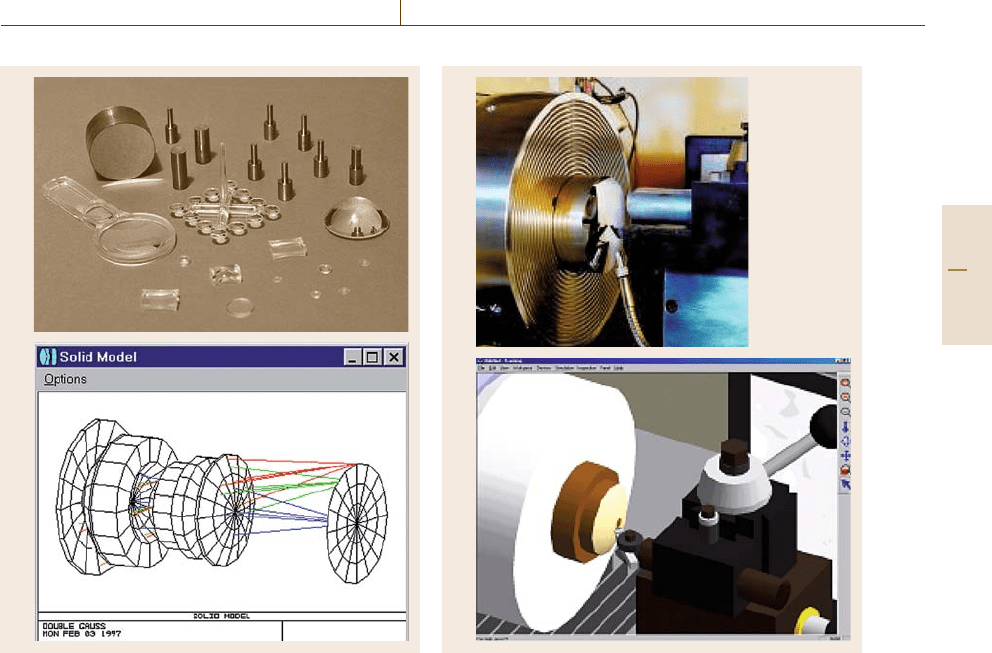
Digital Manufacturing and RFID-Based Automation 49.4 Case Studies of Digital Manufacturing and RFID-Based Automation 869
a)
b)
Fig. 49.11 (a) Precision optical products and (b) their
computer-aided optics design
prototyping ultraprecision machining and inspection of
the design, and manufacture of precision optical prod-
ucts. Interaction between the virtual and real worlds is
accomplished by continuous training and by monitor-
ing the performance of the VMIS system by comparing
the simulation results and the real cutting test results
(Fig.49.15).
The feasibility of a product design and the optimal
resources needed to turn a design into a real product can
be determined prior to any manufacturing resources be-
ing committed and before any costly scrap is generated.
The VMIS allows the precision optics manufacturers
to evaluate the feasibility of an optical product design
and a manufacturing process plan prior to actual pro-
duction. This avoids the need for conducting expensive
production trials and physical prototyping.
49.4.3 Physical Asset Management (PAM)
A physical asset management (PAM) program involves
the tracking of physical assets such as expensive ma-
a)
b)
Fig. 49.12a,b Comparison between (a) actual and (b) vir-
tual machining process
chinery and equipment, as well as returnable items such
as containers and pallets. Across industries and regions,
PAM is a major concern in the manufacturing indus-
try. PAM includes engineering activities, as well as the
adoption of a variety of approaches to maintenance
such asreliability-centered maintenance,multiskills, to-
tal productive maintenance, and hazard and operability
studies [49.34]. Manufacturing enterprises that have
better PAM systems usually excel when compared with
their counterparts in terms of utilization of assets in
manufacturing. However, manyorganizationstoday still
face significant challenges in relation to tracking the
location, quantity, condition, and maintenance and de-
preciation status of their fixed assets.
Traditionally, a popular approach is to track fixed
assets by utilizing serially numbered asset tags, such as
barcodes, for easy and accurate reading. This process
is often performed by scanning a barcode on a physical
asset identification (ID) tag that has been affixed to the
asset. However, PAM may also involve a physical as-
set ID tag with a human-readable number only, which
Part F 49.4
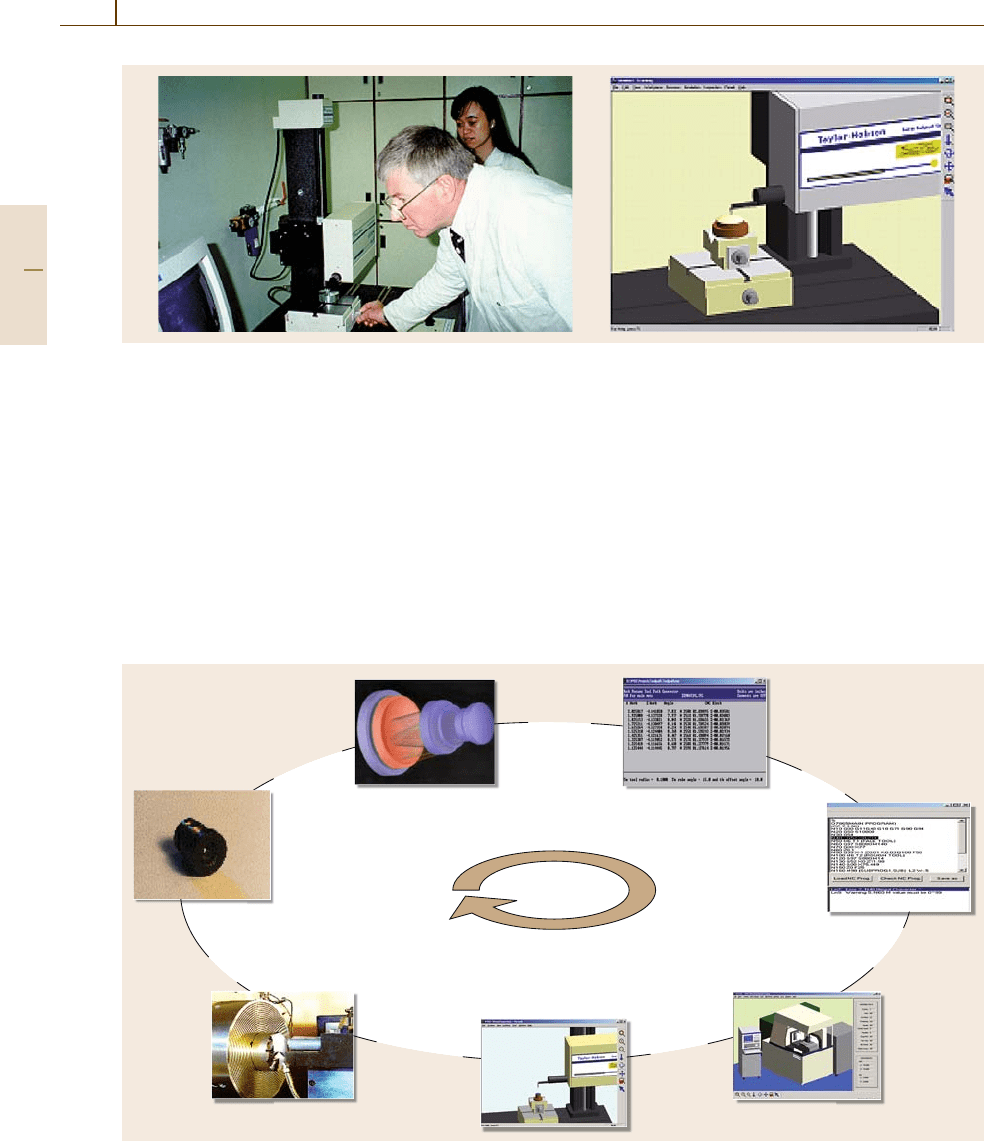
870 Part F Industrial Automation
a) b)
Fig. 49.13a,b Comparison between (a) actual and (b) virtual inspection of precision optics
is documented manually. The barcode approach has its
limitations though, e.g., lack of automation and inability
to provide real-time tracking.
To increase the utilization rate of movable equip-
ment, manufacturing enterprises usually adopt a fluid
approach to the composition of production lines.
Movable equipment is shared across lines for some
nonbottleneck procedures. Previously, applications for
transfer of physical assets required tedious manual
operations. Since most manufacturing processes were
related to the requested equipment, late arrival of equip-
NC programs generated
with the TPG software
Optimal
design
parameters
NC
programs
Driving
codes
Information
for actual
machining
Virtual
product
Optical design
specifications
Optics design with the
ZEMAX software
The actual optical
mould insert is
manufactured by the SPDT
The virtual optical
mould insert is tested
by the VIM
The machining
processes are simu-
lated by the VMM
NC programs
treated with the
tool path translator
Customer's
demand
Fig. 49.14 Graphical illustration of the process flow for the design and manufacture of precision optics (SPDT – single-
point diamond turning, VMM – virtual machining module, VIM – virtual inspection module)
ment lowered the overall efficiency of the company,
which in turn impacted on the company’s profit mar-
gin. Also, as the transfer records were entered into
a database after a long verification process, the time-
liness of the information was questionable. Worse,
due to inevitable human errors, the database records
were incomplete and inaccurate. Common discrepan-
cies included asset locations, utilization, and history of
maintenance and repair. As a result, equipment could
not be repaired in a timely fashion and some was even
lost.
Part F 49.4
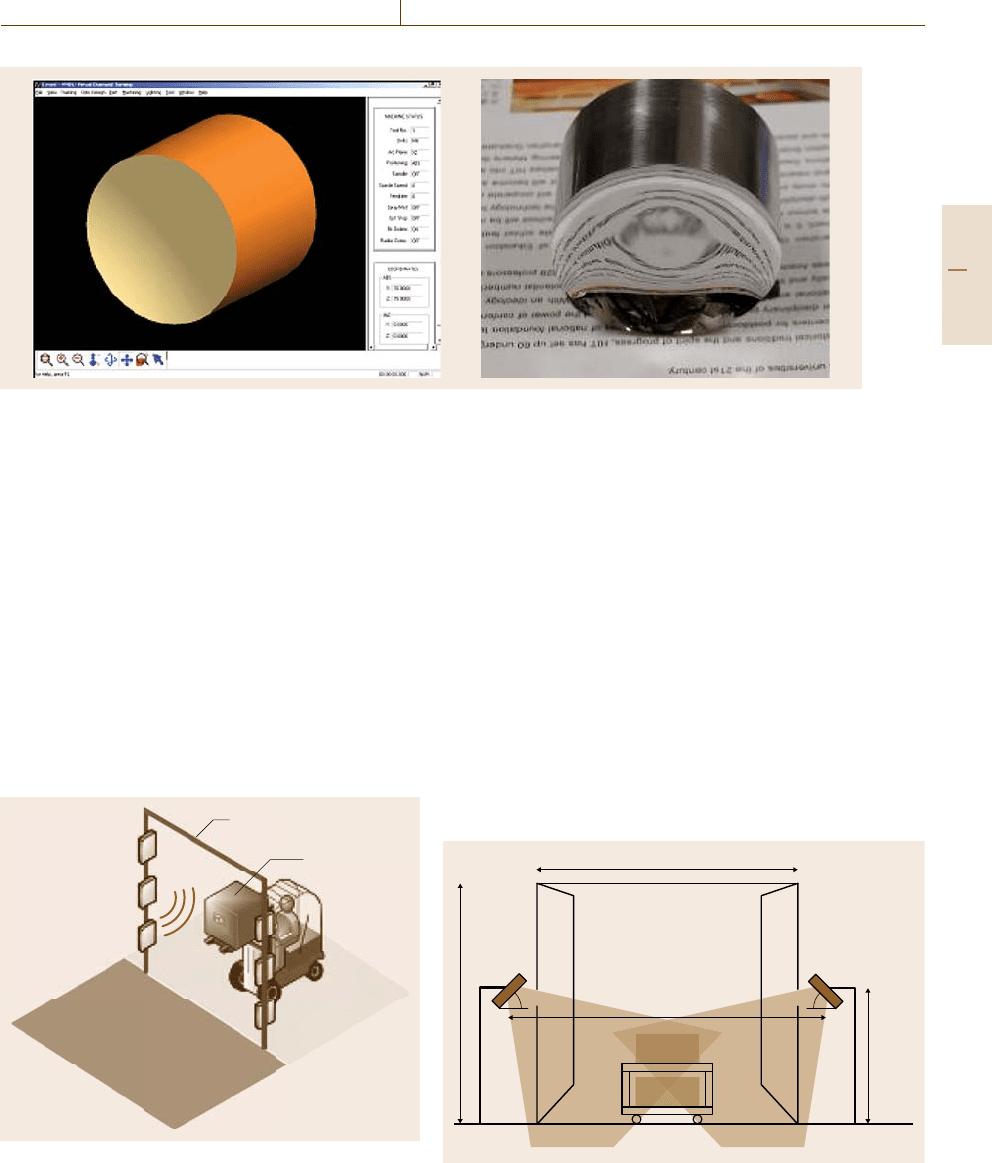
Digital Manufacturing and RFID-Based Automation 49.4 Case Studies of Digital Manufacturing and RFID-Based Automation 871
a) b)
Fig. 49.15 (a) Virtual and (b) actual mold inserts produced based on the VMIS
To improve the overall efficiency and increase the
visibility of physical assets, an RFID-enabled solution
is used to track the movement of physical assets easily
when they pass through antenna detection points with-
out interfering with normal operations. It was therefore
proposed that RFID antennas should be set up near the
door of each production site so that the moving in and
out of physical assets would be automatically recorded,
as illustrated in Figs. 49.16 and 49.17.
RF signals are affected by metal because of in-
terference and reflection from it, which affects the
readability of RFID tags. Since most equipment is made
of metal, this is one of the main challenges of im-
plementing an RFID-enabled solution in the plant. To
address this problem, a feasibility study was carried
RFID gateway
Moveable asset
with RFID tag
Warehouse/
production cell
Warehouse/
production cell
Fig. 49.16 Tracking the movement of equipment by RFID
technology
out to investigate the necessary settings for satisfactory
RFID-enabled tracking performance. Several experi-
ments were performed and the results are shown in
Fig.49.18. Special attention was given to the height and
angle of the antennas in order to provide optimal results
for autotracking.
To evaluate the feasibility of the proposed RFID-
enabled PAM system, a case study was carried out in
a selected company named SAE Magnetics (HK) Ltd.,
which is one of the world’s largest independent man-
ufacturers of magnetic recording heads for hard-disk
drives used in computers and, increasingly, in consumer
electronics such as digital video recorders, MP3 play-
ers, and even mobile phones. While the bulk of SAE’s
operations are based in two modern facilities located in
mainland China, the company needs to manage large-
scale warehouses for its sophisticated logistics. Differ-
202 cm
173 cm
Metal
cart
Door
Machine 1
Machine 2
200 cm
AntennaAntenna
117 cm
45°45°
Fig. 49.17 Deployment setup of RFID gateway
Part F 49.4
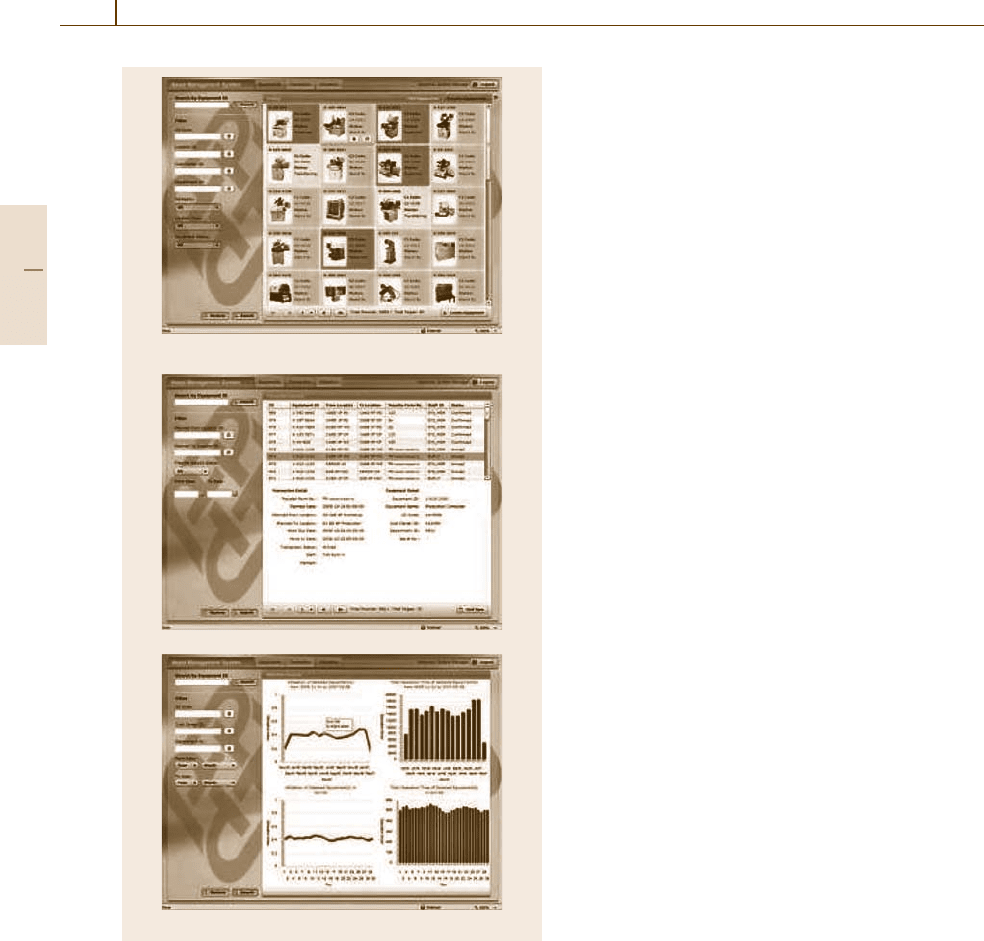
872 Part F Industrial Automation
• Trace and track equipment status
• Equipment transfer
• Transfer record tracking
• Asset utilization analysis
Fig. 49.18 Snapshots of the RFID-enabled equipment
tracking system in SAE
ent kinds of equipment are stored in these warehouses,
e.g., semiproducts, subassemblies, and equipment parts
(collectively known as physical assets). It is normal for
movable physical assets to be transferred from one site
to another to maximize their use, e.g., production equip-
ment and assets that are costly and advanced. In the
past, SAE’s warehouses adopted a pen-and-paper ap-
proach to record the transfer of physical assets. In time,
this became a complicated process that generated piles
of forms and involved many approval processes, which
ultimately limited the company’s operational efficiency.
This new method has enabled equipment or re-
quired parts and subassemblies to arrive promptly and
has increased the utilization of important and valuable
physical assets for the company. This system automat-
ically tracks the transfer of physical assets and greatly
reduces the processing time of equipment transfer. With
the data transfer between the system and RFID devices
being in real time, information about physical assets
can be captured. These data are then presented in the
RFID-enabled equipment tracking system in a system-
atic way, as shown in Fig.49.18. The system provides
the ability to track and trace the status of equipment,
issue equipment transfer orders, and provides reports
for asset utilization analysis. As a result, location and
utilization of equipment can be easily identified using
visual diagrams that help in maintenance planning and
repair scheduling.
The introduction of an RFID-enabled equipment
tracking system at SAE enabled the operational in-
efficiencies associated with the PAM approach to be
targeted and allowed the equipment transfer operation
and production planning at SAE to be streamlined. The
system has generated great benefits for the company,
and has ultimately achieved cost savings while enhanc-
ing the effectiveness of asset management.
49.4.4 Warehouse Management
Warehouse management in manufacturing enterprises
usually requires much more complex and accurate sys-
tems than are required for warehouse management in
other industries. Since a single company takes care of
a tremendous amount of stock for multiple vendors at
one time, the loading for handling the warehouse in-
formation is especially heavy. It is also common for
a single warehouse to be used to store stock from
different vendors so as to enhance utilization rates.
Such an approach also increases the complexity of
warehouse storage structures. Without an accurate, au-
tomated, and comprehensive stock transfer recording
procedure, warehouse management becomes a tremen-
dous challenge.
It is interesting to note that many warehouses in
manufacturing enterprises still rely on sophisticated
manual processes for validating and checking to en-
sure service quality, and these have been responsible
for limiting the efficiency of the operation; for example,
updating inventory lists in the warehouse, checking of
Part F 49.4
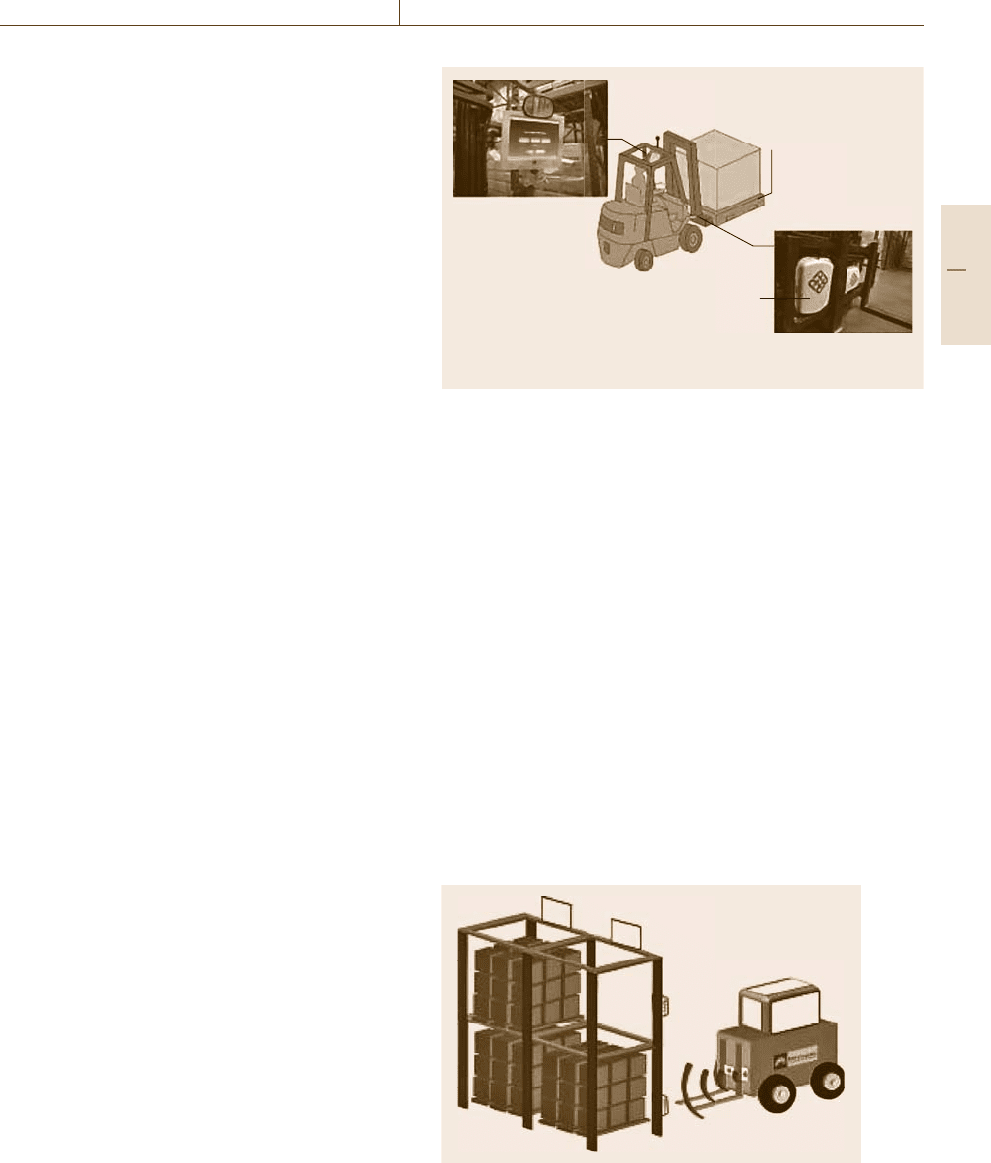
Digital Manufacturing and RFID-Based Automation 49.4 Case Studies of Digital Manufacturing and RFID-Based Automation 873
replenishment requirements, and entering updated data
into the Kerry warehouse managementsystem (KWMS)
are all manual processes. Not surprisingly, these paper-
based processes are excessively time consuming and
susceptible to manual errors.
Low warehouse visibility is another main area of
concern. Warehouse visibility can be evaluated by mea-
suring the discrepancy between the actual status and
the system warehouse inventory status. Since the sys-
tem is such that warehouse inventory status is only
updated after office staff have entered all the latest in-
formation intothe KWMS,there might be a discrepancy
between the actual status and the system warehouse in-
ventory status. As a result, staff might not know the
real-time warehouse inventory status from the KWMS.
Such information gaps could result in wrong decisions
in inbound, relocation, and outbound processes. This
is especially important for dialysis solutions since they
have a limited period of validity. Extensive warehouse
storage time causes product expiry and ultimately finan-
cial loss to the company.
To address these problems, RFID is used to in-
crease the visibility of the warehouse and to streamline
warehouse operations. Through the implementation of
RFID-enabled solutions in warehouse management, in-
stant and accurate inventory records with automatic
real-time record update and physical stocktaking can be
achieved. However, most of the existing RFID-enabled
solutions for warehouse management are lacking in
automation. In thepresent study, an RFID-enabledintel-
ligent forklift is proposed to achieve a higher degree of
automation for the warehouse management via RFID.
Two RFID antennas were placed at the front of the fork-
lift, as shown in Fig.49.19, one for location scanning
and the other for pallet scanning. A tailor-made appli-
cation was installed in the mobile computer placed in
the forklift, which is used to show the information cap-
tured by the antennas and the information stored in the
database system. Forklift drivers can view the informa-
tion on the vehicle-mounted computer screen.
A tag containing product storage information, in-
cluding particular stock keeping unit (SKU)andlot
numbers, is pasted to each pallet. At the same time,
RFID tags that store unique location information are
placed on the racks. When a driver has loaded a pallet
onto the forklift, the pallet information is scanned auto-
matically and that product information and its planned
location are shown on the screen attached to the forklift
(Fig.49.20). After the pallet has been placed in the stor-
age position, the forklift scans the location tag on the
rack, and completes the stock-in process (Fig.49.21).
RFID-enabled pallet
or container
RFID antenna and
cabling
RFID antenna
for pallet scanning
RFID antenna for
location scanning
Vehicle-mounted
computer
Fig. 49.19 The RFID-enabled intelligent forklift
With such modifications in warehouse operation,
numerous benefits can be achieved. Since most paper
processes are eliminated by RFID-enabled automation,
both the speed and accuracy of the stock transaction
process are greatly enhanced; for example, warehouse
staff are no longer required to fill in put-away lists and
relocation lists, neither do they need to input data man-
ually.
To realize the capability of the RFID-enabled intel-
ligent forklift, a case study was carried out in a selected
company named Kerry Logistics (Hong Kong) Limited.
Kerry Logistics (Hong Kong) Limited is part of the di-
versified international conglomerate, the Kuok Group,
and is a subsidiary of the Hong-Kong-listed KerryProp-
erties Limited. Kerry’s Asian logistics business has been
built on more than two decades of warehousing and lo-
gistics operations in Hong Kong. Itsthird-party logistics
(3PL) business has dramatically accelerated since 1998.
Kerry Logistics now encompasses contract logistics,
Fig. 49.20 Location RFID scanning
Part F 49.4

874 Part F Industrial Automation
Fig. 49.21 Pallet RFID scanning
distribution centers, international air and sea freight for-
warding, transportation, distribution, and value-added
services.
Like most third-party logistics (3PL) service
providers around the world, Kerry Logistics has re-
cently recognized some inefficiency in the warehouse
management of one of its major logistics centers lo-
cated in Kwai Chung. Because of the complexity of
taking care of multiple companies and products at the
same time, 3PL service providers require considerable
documentation to record the mass of information gen-
erated in the course of their work. One warehouse
inside the logistics center stores healthcare products,
especially dialysis solutions, for renal patients. To re-
duce human error and streamline the operation flow, an
RFID-enabled intelligent forklift was developed.
With such modifications in warehouse operation,
numerous benefits can be achieved. Since most paper
processes are eliminated by RFID-enabled automation,
both the speed and accuracy of the stock transaction
process are greatly enhanced. For example, warehouse
staffs are no longer required to fill in put-away lists
and relocation lists, neither do they need to input lo-
cation information manually into the KWMS,asthis
kind of activity is done automatically by the RFID
system. Without tedious paper-based location mapping,
the overall speed of the inbound process has improved
by almost 15%, not to mention the cost saving fac-
tors of increased accuracy and reduced manpower. In
addition, the RFID-enabled intelligent forklift allows
for unstructured storage, which completely eliminates
the relocation process. Forklift drivers can freely lo-
cate pallets of stock on the racks, and subsequently
map their respective location information with only
a few clicks. The flexibility of stock positioning is
thus improved, resulting in better utilization of ware-
house space and further shortened inbound processing
time.
49.4.5 Information Interchange
in Global Production Networks
The trend towards the establishment of a global produc-
tion network in the manufacturing industry poses some
new challenges to information interchange; for exam-
ple, some components of a product may be produced
in one country, some part of the product may be out-
sourced and made in a second country, and the final
assembly of the finished product may be done a third
country, before being ultimately sold somewhere else.
However, apart from the obvious need for collaboration,
the problems of data integration and information shar-
ing within the supply chain are challenging. Therefore,
an RFID-based intra-supply-chain information system
(ISCIS) is much needed in order to streamline the
supply-chain activities and form an intra-supply-chain
network.
Figure 49.22 shows the architecture of a proposed
RFID-based ISCIS which is basically divided into plat-
form tiers. The system consists of the application of
RFID tags to generate the data within the supply-chain
network. Data from the RFID tags is scanned by readers
and synchronizedwith the internal information systems.
The RFID-based ISCIS enables the different partners in
the supply chain to share real-time information.
1. Data acquisition tier: The data from the operational
level on the textile supply chain are captured by
RFID technology. RFID readers are installed in the
warehouses of the textile and apparel manufacturers
and at the retailers. Tags are placed either at the pal-
let level or the item level, depending on the stage
in the supply chain. At the level of the individual
item of merchandise it is difficult to achieve 100%
reading accuracy with RFID tags.However,itisal-
ready technically feasible to track RFID tags at the
pallet or carton level. As the raw materials progress
through the stages of WIP to the finished goods, the
tagging level changes from the pallet level to the
carton level and finally to the item level.
2. Information systems tier: This integrates the RFID-
based information systems with the internal in-
formation systems of the different supply-chain
partners, such as enterprise resources planning
(ERP) systems. The most successful new busi-
ness models are probably those that can integrate
information technology into all activities of the
enterprise-wide value chain.
Part F 49.4
